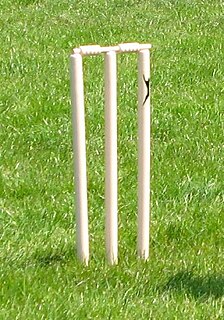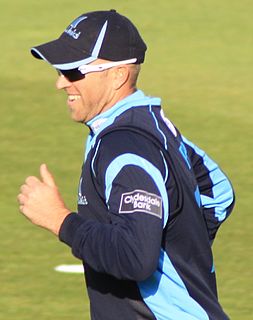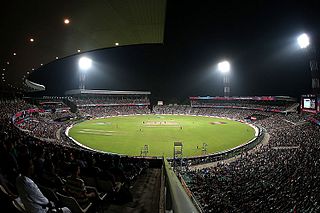
Fielding in the sport of cricket is the action of fielders in collecting the ball after it is struck by the striking batter, to limit the number of runs that the striker scores and/or to get a batter out by either catching a hit ball before it bounces, or by running out either batter before they can complete the run they are currently attempting. There are a number of recognised fielding positions, and they can be categorised into the offside and leg side of the field. Fielding also involves preventing the ball from going to or over the edge of the field.
The Laws of Cricket is a code which specifies the rules of the game of cricket worldwide. The earliest known code was drafted in 1744 and, since 1788, it has been owned and maintained by its custodian, the Marylebone Cricket Club (MCC) in London. There are currently 42 Laws which outline all aspects of how the game is to be played. MCC has re-coded the Laws six times, the seventh and latest code being released in October 2017. The 2nd edition of the 2017 Code came into force on 1 April 2019. The first six codes prior to 2017 were all subject to interim revisions and so exist in more than one version.

In cricket, the term wicket has several meanings:

This is a general glossary of the terminology used in the sport of cricket. Where words in a sentence are also defined elsewhere in this article, they appear in italics. Certain aspects of cricket terminology are explained in more detail in cricket statistics and the naming of fielding positions is explained at fielding (cricket).
In cricket, a no-ball is an illegal delivery to a batter. It is also the extra run awarded to the batting team as a consequence. For most cricket games, especially amateur the definition of all forms of no-ball is from the MCC Laws of Cricket.
The history of Test cricket between 1884 and 1889 was one of English dominance over the Australians. England won every Test series that was played. The period also saw the first use of the word "Test" to describe a form of cricket when the Press used it in 1885. It has remained in common usage ever since.

The Australian cricket team in England in 1948 is famous for being the only Test match side to play an entire tour of England without losing a match. This feat earned them the nickname of "The Invincibles", and they are regarded as one of the greatest cricket teams of all time. According to the Australian federal government the team "is one of Australia's most cherished sporting legends". The team was captained by Don Bradman, who was making his fourth and final tour of England.
Bangladesh A toured England in July and August 2005 for first class and List A cricket matches against English domestic teams. The team struggled in the first class matches, where they drew two and lost three matches, and only looked like having a chance of winning in the last match against Kent. The one-day series went slightly better, with Bangladesh A winning two, losing one and abandoning a fourth, but for a second string national team against mainly second elevens from English domestic cricket, it was a highly disappointing tour.

Matthew James Prior is a South African-born English former cricketer, who played for England in Test cricket and for Sussex County Cricket Club in domestic cricket. He was a wicket-keeper and his aggressive right-handed batting enabled him to open the innings in ODI matches, even when he made very limited appearance in shorter forms of the game. With an international Test debut score of 126, Prior became the first English wicket-keeper to hit a century in his debut match in early 2007. His glovework, however, was criticised. Despite a successful tour of Sri Lanka with the bat, Prior's keeping was less successful, and he was dropped from the team for the 2008 tour of New Zealand. He returned for the 2008 series against South Africa, and was retained into 2009, where he became the second-fastest England keeper to reach 1,000 Test runs, behind Les Ames. He retired in June 2015 from all forms of professional cricket due to a recurring Achilles tendon injury.
The 2005–06 edition of the VB Series was a three-team One Day International men's cricket tournament held in Australia in January and February 2006, between the hosting nation's team, South Africa and Sri Lanka.. The teams played each other four with five points awarded for a win and a possible bonus point awarded either to the winners or losers depending on run rate. The top two teams on points went through to the best-of-three finals series. All matches were day-night matches except the final meeting between South Africa and Sri Lanka.
The West Indies cricket team toured Australia in the 1960–61 season under the captaincy of Frank Worrell. Both Worrell and his opposing captain, Richie Benaud, encouraged their teams to play attacking cricket. The first Test of the five match series ended in a dramatic tie, the first of only two instances in Test cricket. Though West Indies narrowly lost the series 2–1, with one draw in addition to the tie, they might easily have won both the last two matches and taken the series 3–1. They took much credit for contributing to such an exciting series and made themselves extremely popular with the Australian public. Prior to their departure from Australia, the team were paraded through Melbourne in open-top cars on 17 February 1961, and were cheered by enormous crowds.
The Indian cricket team began a tour of Australia in December 2007, playing the 4 match Test series for the Border Gavaskar Trophy, followed by a single Twenty20 match on 1 February 2008. They also participated in the Commonwealth Bank tri-series against Australia and Sri Lanka from 3 February to 4 March.

The 1948 Ashes series was that year's edition of the long-standing cricket rivalry between England and Australia. Starting on 10 June 1948, England and Australia played five Tests. Australia had not lost a Test since the Second World War and were strong favourites. Their captain Don Bradman had publicly expressed his ambition of going through the tour without defeat, and Australia won 10 of their 12 lead-up matches, eight by an innings. The England team, however, had several notable players themselves, including Len Hutton, Denis Compton and Alec Bedser. Nevertheless, the final result was a 4–0 series win for Australia, with the Third Test being drawn. They thus retained The Ashes. The Australians remained undefeated for their entire tour of England, earning them the sobriquet of The Invincibles.
Keith Miller was part of the Australian cricket team that toured England in 1953. While Miller was personally successful on tour, Australia lost the Ashes series to England, one Test to nil.

The Fourth Test of the 1948 Ashes series was one of five Tests in a cricket series between Australia and England. The match was played at Headingley Cricket Ground at Leeds from 22 to 27 July with a rest day on 25 July. Australia won the match by seven wickets to take an unassailable 3–0 series lead. In successfully chasing a target of 404, they set a new world record for the highest victorious runchase in Test history, a record lasting until 1976.

The First Test of the 1948 Ashes series was one of five Tests in the Ashes cricket series between Australia and England. The match was played at Trent Bridge in Nottingham from 10 to 15 June with a rest day on 13 June 1948. Australia won the match by eight wickets to take a 1–0 series lead.

Ian Johnson was a member of Donald Bradman's famous Australian cricket team, which toured England in 1948. Bradman's men went undefeated in their 34 matches; this unprecedented feat by a Test side touring England earned them the sobriquet The Invincibles.
The England cricket team toured Bangladesh at the end of the 2009–10 cricket season, playing three One Day Internationals (ODI) and two Test matches. Regular England captain Andrew Strauss controversially missed the tour to rest for the 2010–11 Ashes series, so the team was led for the first time by Alastair Cook. Bangladesh were captained by all-rounder Shakib Al Hasan.

Cricket is a bat-and-ball game played between two teams of eleven players each on a field at the centre of which is a 22-yard (20-metre) pitch with a wicket at each end, each comprising two bails balanced on three stumps. The game proceeds when a player on the fielding team, called the bowler, "bowls" (propels) the ball from one end of the pitch towards the wicket at the other end, with an "over" being completed once they have legally done so six times. The batting side has one player at each end of the pitch, with the player at the opposite end of the pitch from the bowler aiming to strike the ball with a bat. The batting side scores runs either when the ball reaches the boundary of the field, or when the two batters swap ends of the pitch, which results in one run. The fielding side's aim is to prevent run-scoring and dismiss each batter. Means of dismissal include being bowled, when the bowled ball hits the stumps and dislodges the bails, and by the fielding side either catching a hit ball before it touches the ground, or hitting a wicket with the ball before a batter can cross the crease line in front of the wicket to complete a run. When ten batters have been dismissed, the innings ends and the teams swap roles. The game is adjudicated by two umpires, aided by a third umpire and match referee in international matches.
On 11 and 12 February 1851, teams from Van Diemen's Land and Port Phillip District played the first cricket match between two Australian colonies, recognised in later years as the inaugural first-class cricket match in Australia. It took place at the Launceston Racecourse, known now as the NTCA Ground, in Tasmania. The match was incorporated into celebrations marking the separation of the Port Phillip District from New South Wales in 1851 as the colony of Victoria.










